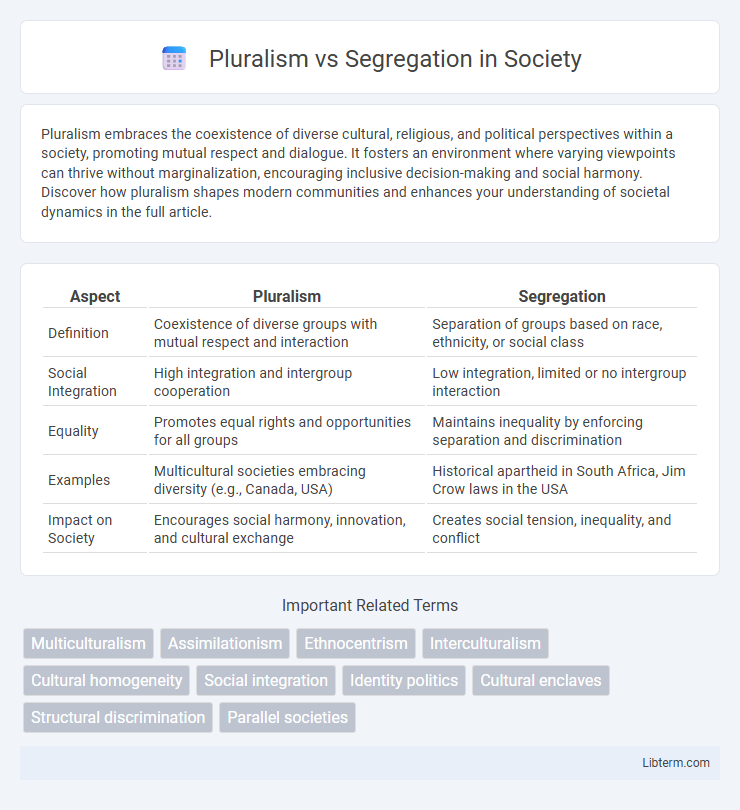Pluralism embraces the coexistence of diverse cultural, religious, and political perspectives within a society, promoting mutual respect and dialogue. It fosters an environment where varying viewpoints can thrive without marginalization, encouraging inclusive decision-making and social harmony. Discover how pluralism shapes modern communities and enhances your understanding of societal dynamics in the full article.
Table of Comparison
| Aspect | Pluralism | Segregation |
|---|---|---|
| Definition | Coexistence of diverse groups with mutual respect and interaction | Separation of groups based on race, ethnicity, or social class |
| Social Integration | High integration and intergroup cooperation | Low integration, limited or no intergroup interaction |
| Equality | Promotes equal rights and opportunities for all groups | Maintains inequality by enforcing separation and discrimination |
| Examples | Multicultural societies embracing diversity (e.g., Canada, USA) | Historical apartheid in South Africa, Jim Crow laws in the USA |
| Impact on Society | Encourages social harmony, innovation, and cultural exchange | Creates social tension, inequality, and conflict |
Understanding Pluralism: Definition and Core Principles
Pluralism emphasizes the coexistence and mutual respect of diverse cultural, ethnic, and social groups within a unified society, promoting inclusion and equal participation. Core principles of pluralism include recognition of diversity, open dialogue, and the protection of minority rights to foster social harmony and cooperation. This approach contrasts with segregation by encouraging interaction and integration rather than separation and isolation.
Segregation Explained: Historical and Modern Contexts
Segregation refers to the enforced separation of different racial, ethnic, or social groups, historically institutionalized through laws such as Jim Crow in the United States and apartheid in South Africa. This system perpetuated inequality by restricting access to resources, education, and economic opportunities based on group identity. Modern contexts of segregation often manifest in residential patterns, school zoning, and economic disparities, reflecting enduring structural barriers despite legal advances toward integration.
The Roots of Pluralism in Society
The roots of pluralism in society stem from the recognition and acceptance of cultural, ethnic, and social diversity within a shared political framework. This foundation promotes coexistence through inclusive institutions that encourage dialogue, mutual respect, and equal participation. Pluralism contrasts segregation by emphasizing integration and the blending of distinct groups rather than separation and isolation.
Social Impact of Segregation
Segregation perpetuates social inequality by limiting access to quality education, healthcare, and economic opportunities for marginalized communities. It fosters environments of systemic discrimination, reducing social mobility and reinforcing stereotypes that deepen societal divisions. The social impact of segregation includes increased poverty rates, heightened crime levels, and reduced overall civic engagement, undermining social cohesion and national unity.
Pluralism and Cultural Diversity
Pluralism promotes cultural diversity by encouraging the coexistence of multiple ethnic, religious, and social groups within a society, fostering mutual respect and inclusion. It supports the preservation of distinct cultural identities while enabling interaction and cooperation, enhancing social cohesion and innovation. Embracing pluralism reduces social conflicts and promotes equitable representation in political, economic, and educational systems.
Segregation’s Effect on Economic Opportunity
Segregation significantly limits economic opportunities by concentrating poverty and restricting access to quality education and employment networks in marginalized communities. This spatial and social separation perpetuates income inequality and impedes wealth accumulation for segregated groups. Persistent residential segregation correlates with reduced economic mobility and widened gaps in earnings and job prospects.
Education: Integration vs. Separation
Educational pluralism fosters diverse learning environments where students from varying cultural, ethnic, and socioeconomic backgrounds interact, promoting inclusivity and mutual understanding. In contrast, segregation in education leads to isolated groups based on race or class, often resulting in unequal resource distribution and limited social mobility. Integrated schools demonstrate higher academic achievement and social cohesion, making diversity a critical component for effective educational outcomes.
Political Systems: Inclusive vs. Exclusive Approaches
Pluralism in political systems promotes inclusive approaches that embrace diverse groups, encouraging participation and cooperation within the governance framework. Segregation, by contrast, enforces exclusive policies that marginalize minority voices, often resulting in political instability and social fragmentation. Inclusive political systems foster democratic legitimacy and social cohesion, while exclusive systems risk perpetuating inequality and undermining collective governance.
Building Cohesion: The Pluralist Approach
The pluralist approach to building cohesion emphasizes embracing cultural diversity and encouraging active dialogue among different social groups to foster mutual understanding and respect. It promotes inclusive policies that safeguard minority rights while enabling equal participation in societal development, thereby reducing social tensions. By valuing diverse perspectives and facilitating collaborative decision-making, pluralism strengthens social bonds and creates a more resilient, harmonious community.
Future Outlook: Toward a More Pluralistic Society
Future societal trends indicate a shift toward pluralism, emphasizing inclusive policies that celebrate cultural diversity and promote equal participation across ethnic and social groups. Emerging technologies and global interconnectedness facilitate cross-cultural dialogues, reducing segregation by encouraging mutual understanding and collaboration. Educational reforms and government initiatives aiming for equitable representation further support the transition toward a more integrated, pluralistic society.
Pluralism Infographic

 libterm.com
libterm.com